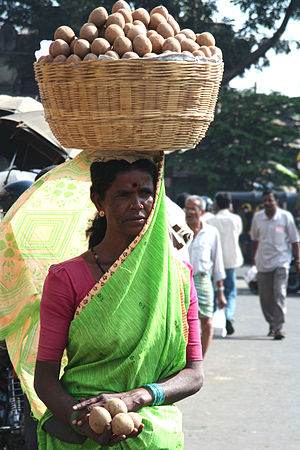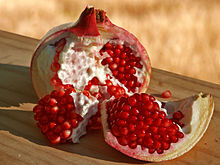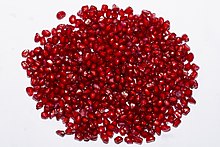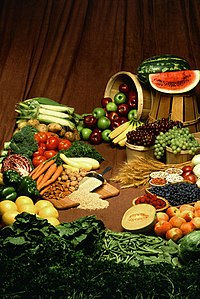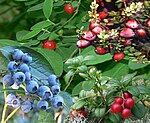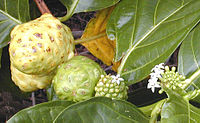Protein (nutrient) ;
From Wikipedia, the free encyclopedia
Proteins are essential nutrients for the human body.
[1] They are one of the building blocks of body tissue, and can also serve as a fuel source. As a fuel, proteins contain 4
kcal per gram, just like
carbohydrates and unlike
lipids,
which contain 9 kcal per gram. The most important aspect and defining
characteristic of protein from a nutritional standpoint is its
amino acid composition.
[2]
Proteins are
polymer chains made of
amino acids linked together by
peptide bonds. During human
digestion, proteins are broken down in the stomach to smaller
polypeptide chains via
hydrochloric acid and
protease actions. This is crucial for the synthesis of the
essential amino acids that cannot be
biosynthesized by the body.
[3]
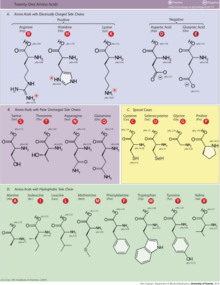
There are nine
essential amino acids which humans must obtain from their diet in order to prevent
protein-energy malnutrition. They are
phenylalanine,
valine,
threonine,
tryptophan,
methionine,
leucine,
isoleucine,
lysine, and
histidine.
[2][4] There are five dispensable amino acids which humans are able to synthesize in the body. These five are
alanine,
aspartic acid,
asparagine,
glutamic acid and
serine.
[2]
There are six conditionally essential amino acids whose synthesis can
be limited under special pathophysiological conditions, such as
prematurity in the infant or individuals in severe catabolic distress.
[2] These six are
arginine,
cysteine,
glycine,
glutamine,
proline and
tyrosine.
[2]
Humans need the essential amino acids in certain ratios. Some protein sources contain amino acids in a more or less
'complete' sense. This has given rise to various ranking systems for protein sources, as described in the article.
Animal sources of protein include meats, dairy products, fish and
eggs. Vegan sources of protein include whole grains, pulses, legumes,
soy, and nuts. Vegetarians and vegans can get enough essential amino
acids by eating a variety of plant proteins.
[5]
It is commonly believed that athletes should consume a
higher-than-normal protein intake to maintain optimal physical
performance.
[2]
Protein functions in body ;
Protein is a nutrient needed by the human body for growth and maintenance.
[1]
Aside from water, proteins are the most abundant kind of molecules in
the body. Protein can be found in all cells of the body and is the major
structural component of all cells in the body, especially muscle.
[1][6] This also includes body organs, hair and skin. Proteins are also used in membranes, such as
glycoproteins. When broken down into amino acids, they are used as precursors to
nucleic acid, co-enzymes, hormones, immune response, cellular repair, and other molecules essential for life.
[6] Additionally, protein is needed to form blood cells.
[1][7]
Protein function in exercise
Proteins are believed to increase performance in terms of athletics.
[7] Amino acids, the building blocks of proteins, are used for building muscle tissue and repairing damaged tissues.
[7] Protein is only used as anaerobic fuel when carbohydrates are low, or as aerobic fuel when lipid resources are also low.
[7]
Sources ;

Protein can be found in a wide range of food. The best combination of
protein sources depends on the region of the world, access, cost, amino
acid types and nutrition balance, as well as acquired tastes. Some
foods are high in certain amino acids, but their digestibility and the
anti-nutritional factors
present in these foods make them of limited value in human nutrition.
Therefore, one must consider digestibility and secondary nutrition
profile such as calories, cholesterol, vitamins and essential mineral
density of the protein source.
[8]
On a worldwide basis, plant protein foods contribute over 60 percent of
the per capita supply of protein, on average. In North America,
animal-derived foods contribute about 70 percent of protein sources.
[citation needed]
Meat, products from milk, eggs, soy, and fish are sources of
complete protein.
[9]
Whole grains and cereals are another source of proteins. However,
these tend to be limiting in the amino acid lysine or threonine, which
are available in other vegetarian sources and meats. Examples of
food staples
and cereal sources of protein, each with a concentration greater than 7
percent, are (in no particular order) buckwheat, oats, rye, millet,
maize (corn), rice, wheat, bulgar, sorghum, amaranth, and quinoa.
Vegetarian sources of proteins include legumes, nuts, seeds and fruits.
Legumes, some of which are called
pulses
in certain parts of the world, have higher concentrations of amino
acids and are more complete sources of protein than whole grains and
cereals. Examples of vegetarian foods with protein concentrations
greater than 7 percent include soybeans, lentils, kidney beans, white
beans, mung beans, chickpeas, cowpeas, lima beans, pigeon peas, lupines,
wing beans, almonds, Brazil nuts, cashews, pecans, walnuts, cotton
seeds, pumpkin seeds, sesame seeds, and sunflower seeds.
[8]
Plant sources of protein.
Food staples that are poor sources of protein include roots and tubers such as
yams,
cassava and
sweet potato.
Plantains,
another major staple, are also a poor source of essential amino acids.
Fruits, while rich in other essential nutrients, are another poor source
of amino acids. The protein content in roots, tubers and fruits is
between 0 and 2 percent. Food staples with low protein content must be
complemented with foods with complete, quality protein content for a
healthy life, particularly in children for proper development.
[1][10][11]
A good source of protein is often a
combination
of various foods, because different foods are rich in different amino
acids. A good source of dietary protein meets two requirements:
[8]
- The requirement for the nutritionally indispensable amino acids
(histidine, isoleucine, leucine, lysine, methionine, phenylalanine,
threonine, tryptophan, and valine) under all conditions and for
conditionally indispensable amino acids (cystine, tyrosine, taurine,
glycine, arginine, glutamine, proline) under specific physiological and
pathological conditions
- The requirement for nonspecific nitrogen for the synthesis of the
nutritionally dispensable amino acids (aspartic acid, asparagine,
glutamic acid, alanine, serine) and other physiologically important
nitrogen-containing compounds such as nucleic acids, creatine, and
porphyrins.
Healthy people eating a balanced diet rarely need protein supplements.
[5][8]
Except for a few amino acids, most are readily available in human diet.
The limiting amino acids are lysine, threonine, tryptophan and
sulfur-containing amino acids.
[10]
The table below presents the most important food groups as protein
sources, from a worldwide perspective. It also lists their respective
performance as source of the commonly limiting amino acids, in
milligrams of limiting amino acid per gram of total protein in the food
source.
[10] The table reiterates the need for a balanced mix of foods to ensure adequate amino acid
Protein quality ;
The most important aspect and defining characteristic of protein from a nutritional standpoint is its
amino acid composition.
[2]
There are multiple systems which rate proteins by their usefulness to
an organism based on their relative percentage of amino acids and, in
some systems, the digestibility of the protein source. They include
biological value,
net protein utilization, and
PDCAAS (Protein Digestibility Corrected Amino Acids Score). Also see
complete protein,
nitrogen balance and
protein combining. The PDCAAS was developed by the FDA as an improvement over the
Protein efficiency ratio
(PER) method. The PDCAAS rating is a fairly recent evaluation method;
it was adopted by the US Food and Drug Administration (FDA) and the Food
and Agricultural Organization of the United Nations/
World Health Organization
(FAO/WHO) in 1993 as "the preferred 'best'" method to determine protein
quality. These organizations have suggested that other methods for
evaluating the quality of protein are inferior.
[13]
Digestion ;
Most proteins are decomposed to single amino acids by digestion in the gastro-intestinal tract.
[14]
Digestion typically begins in the stomach when
pepsinogen is converted to
pepsin by the action of
hydrochloric acid, and continued by
trypsin and
chymotrypsin in the small intestine.
[14] Before the absorption in the
small intestine,
most proteins are already reduced to single amino acid or peptides of
several amino acids. Most peptides longer than four amino acids are not
absorbed. Absorption into the
intestinal absorptive cells is not the end. There, most of the peptides are broken into single amino acids.
Absorption of the amino acids and their
derivatives into which dietary protein is degraded is done by the
gastrointestinal tract.
The absorption rates of individual amino acids are highly dependent on
the protein source; for example, the digestibilities of many amino acids
in humans, the difference between
soy and milk proteins
[15] and between individual milk proteins,
beta-lactoglobulin and casein.
[16] For milk proteins, about 50% of the ingested protein is absorbed between the stomach and the
jejunum and 90% is absorbed by the time the digested food reaches the
ileum.
[17]
Biological value (BV) is a measure of the proportion of absorbed
protein from a food which becomes incorporated into the proteins of the
organism's body.
Dietary requirements ;
Considerable debate has taken place regarding issues surrounding protein intake requirements.
[18][19]
The amount of protein required in a person's diet is determined in
large part by overall energy intake, the body's need for nitrogen and
essential amino acids, body weight and composition, rate of growth in
the individual, physical activity level, individual's energy and
carbohydrate intake, as well as the presence of illness or injury.
[3][12][20]
Physical activity and exertion as well as enhanced muscular mass
increase the need for protein. Requirements are also greater during
childhood for growth and development, during pregnancy or when
breast-feeding in order to nourish a baby, or when the body needs to
recover from malnutrition or trauma or after an operation.
[21]
If not enough energy is taken in through diet, as in the process of
starvation,
the body will use protein from the muscle mass to meet its energy
needs, leading to muscle wasting over time. If the individual does not
consume adequate protein in nutrition, then muscle will also waste as
more vital cellular processes (e.g. respiration enzymes, blood cells)
recycle muscle protein for their own requirements.
According to US & Canadian
Dietary Reference Intake
guidelines, women aged 19–70 need to consume 46 grams of protein per
day, while men aged 19–70 need to consume 56 grams of protein per day to
avoid a deficiency.
[22] The generally accepted daily protein dietary allowance, measured as intake per kilogram of body weight, is 0.8 g/kg.
[18] However, this recommendation is based on structural requirements, but disregards use of protein for
energy metabolism.
[18] This requirement is for a normal sedentary person.
[20]
Several studies have concluded that active people and athletes may
require elevated protein intake (compared to 0.8 g/kg) due to increase
in muscle mass and sweat losses, as well as need for body repair and
energy source.
[18][19][20] Suggested amounts vary between 1.6 g/kg and 1.8 g/kg,
[19] while a proposed
maximum daily protein intake would be approximately 25% of energy requirements i.e. approximately 2 to 2.5 g/kg.
[18] However, many questions still remain to be resolved.
[19]
Aerobic exercise protein needs ;
Endurance athletes differ from strength-building athletes in that endurance athletes do not build muscle mass from training.
[citation needed]
Research suggests that individuals performing endurance activity
require more protein intake than sedentary individuals so that muscles
broken down during endurance workouts can be repaired.
[23]
Although the protein requirement for athletes still remains
controversial (for instance see Lamont, Nutrition Research Reviews, pges
142 - 149, 2012), research does show that endurance athletes can
benefit from increasing protein intake because the type of exercise
endurance athletes participate in still alters the protein metabolism
pathway. The overall protein requirement increases because of amino acid
oxidation in endurance-trained athletes.
[23]
Endurance athletes who exercise over a long period (2–5 hours per
training session) use protein as a source of 5–10% of their total energy
expended. Therefore, a slight increase in protein intake may be
beneficial to endurance athletes by replacing the protein lost in energy
expenditure and protein lost in repairing muscles. Some scientists
suggest that endurance athletes may increase daily protein intake to a
maximum of 1.2–1.4 g per kg body weight.
Excess consumption ;
When a high dietary protein intake is consumed, there is an increase
in urea excretion, which suggests that amino acid oxidation is
increased.
[20] High levels of protein intake increase the activity of branched-chain ketoacid dehydrogenase.
[20] As a result, oxidation is facilitated, and the amino group of the amino acid is excreted to the liver.
[20] This process suggests that excess protein consumption results in protein oxidation and that the protein is excreted.
[20] The body is unable to store excess protein.
[20][25]
Protein is digested into amino acids, which enter the bloodstream.
Excess amino acids are converted to other usable molecules by the liver
in a process called
deamination. Deamination converts nitrogen from the amino acid into ammonia, which is converted by the liver into urea in the
urea cycle. Excretion of urea is performed by the kidneys. These organs can normally cope with any extra workload, but, if
kidney disease occurs, a decrease in protein will often be prescribed.
[26] When there is excess protein intake, amino acids can be converted to
glucose or
ketones, in addition to being oxidized for fuel.
[27]
When food protein intake is periodically high or low, the body tries to
keep protein levels at an equilibrium by using the "labile protein
reserve", which serves as a short-term protein store to be used for
emergencies or daily variations in protein intake.
[6] However, that reserve is not utilized as longer-term storage for future needs.
[6]
Many researchers have also found that excessive intake of protein increases calcium excretion in urine.
[6] It has been thought that this occurs to maintain the pH imbalance from the oxidation of sulfur amino acids.
[6] Also, it is inconclusive whether
bone resorption contributes to bone loss and osteoporosis.
[6] However, it is also found that a regular intake of calcium would be able to stabilize this loss.
[6]
Another issue arising from over-consumption of protein is a higher
risk of kidney stone formation from calcium in the renal circulatory
system.
[6]
It has been found that high animal protein intake in healthy
individuals increases the probability of forming kidney stones by 250
percent.
[citation needed]
An epidemiological study from 2006 has found no relationship between
total protein intake and blood pressure; it did, however, find an
inverse relationship between vegetable protein intake and blood
pressure.
[28]
Protein deficiency ;
Protein deficiency and malnutrition can lead to variety of ailments including
mental retardation and
kwashiorkor.
[11]
Symptoms of kwashiorkor include apathy, diarrhea, inactivity, failure
to grow, flaky skin, fatty liver, and edema of the belly and legs. This
edema is explained by the action of lipoxygenase on arachidonic acid to
form leukotrienes and the normal functioning of proteins in fluid
balance and lipoprotein transport.
[37]
PEM is fairly common worldwide in both children and adults and accounts for 6 million deaths annually.
[2]
In the industrialized world, PEM is predominantly seen in hospitals, is
associated with disease, or is often found in the elderly.
[2]

















